One of the things you don’t want to overlook for disaster preparedness is your toilet. While plumbing often does work during power outages and small-scale disasters, it wouldn’t take much for the plumbing system to go down.
And, if it did, we could have a massive sanitation disaster on our hands. To make sure nothing hits the fan, you need an emergency toilet. One option is a camping toilet.
Most Camping Toilets Are Terrible for Emergency Prep!
Before you rush out, buy a camping toilet, and call yourself prepped, know that most camping toilets are terrible for emergency preparedness.
They get messy. They fill quickly. And where the hell are you supposed to dump it when it’s full???
I recommend a portable composting toilet instead of a camping toilet or even a DIY composting toilet. You can read our picks for the best composting toilets here.
However, composting toilets are a bit pricey, and you must have a compost heap to use them. So, a portable camping toilet might make sense in some situations.
This guide will give you some good options for camping toilets and also troubleshoot all the issues with using them when the plumbing is down.
Best Options Overview
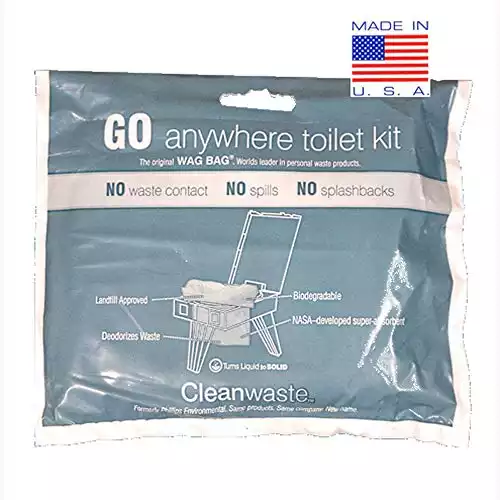 Go Anywhere Toilet Kit 12-pack (Wag bags)
Go Anywhere Toilet Kit 12-pack (Wag bags)
Best for: Shorter-term emergencies. They can also work for longer-term emergencies, but buying that many bags can get pricey. Assuming that you only use for #2, plan for about 1-2 bags per person per day.
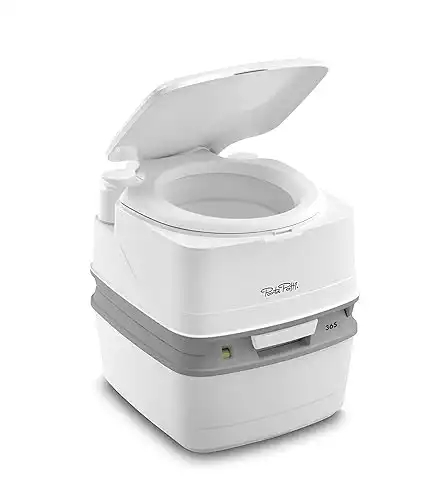 Thetford Porta Potti
Thetford Porta Potti
Best For: Longer-term emergencies, but only if you also have a place for emptying the tank (such as a yard where you can dig a pit).
Types of Camping Toilets
Camping toilets are essentially seats that have a collection device at the bottom. They can be broken down by the type of collection device they use.
There are three main options:
Option 1: Bag Camping Toilets (NOT RECOMMENDED!!!)
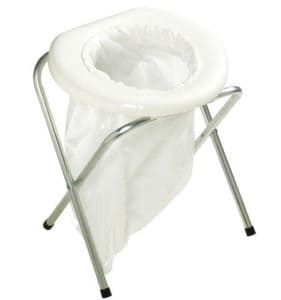
On many websites, I’ve seen “bag” type camping toilets recommended for emergency prep. These are basically chairs with a toilet seat and a plastic bag attached below for collecting waste.
Note: This is actually how many people in underdeveloped nations go to the bathroom. In urban slums in Kenya, for example, people go to the bathroom in ordinary plastic bags. Then they literally fling it away, hence the name “flyaway toilets.” Imagine getting hit by one of those. Disgusting! (Source)
DO NOT GET ONE OF THESE! Why? Because…
- The bag will break or leak.
- You will slosh yourself when you go to empty the bag.
- And where the heck are you emptying the bag? You’ll have to tie off the bags of waste and keep them lying around until authorities tell you how to get rid of them.
Instead of going this route, I’d recommend the twin-bucket system.
With the two-bucket system, you use buckets (which won’t leak or break like bags). One bucket is used for pee, and the other for poo.
By keeping pee and poo separate, you eliminate all possible sloshing. The pee can be safely dumped outside. The poo doesn’t take up much space. It can be bagged up or dumped in a latrine.
Read more about the twin bucket toilet system here.
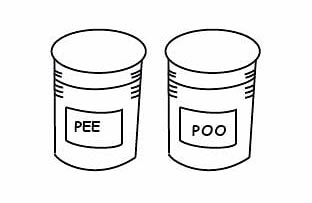
You could use a bag toilet if you were completely unprepared for an emergency. It would be fine for up to a few days. After that, you’d end up with too many bags of human waste in your home. Gross, right?
Option 2: WAG Bags
WAG stands for “Waste Alleviation and Gelling.” They are made by the company Cleanwaste (now called the “Go Anywhere Toilet kit, but most still refer to them as WAG bags). Many backpackers are familiar with wag bags because some national parks now require hikers to pack out their waste.
How They Work
The way wag bags work is with a special gelling agent. The gelling agent is either added to the bag or is already added to the bag’s lining. When liquid waste comes in contact with the gelling agent, it causes the waste to become solid. Disposing of solid waste is much easier since you don’t have to worry about leakage or spills. Thus, you can easily carry the wag bag to a disposal site.
For emergency planning, wag bags can work very well. You still end up with bags of waste lying around your home or yard. But the gelling agent means they won’t smell or be messy. Once trash collection resumes, you can toss all of the bags.
The only issue with wag bags is that they can be costly, usually around $10 per bag. Even if you only use them for #2, the cost can still add up quickly. Buying them in bulk is much cheaper.
The pack of 12 Go Bags we recommend is relatively affordable.
Disposing of Wag Bags
The chemicals in wag bags render human waste inert. So you can safely dispose of the wag bag in the trash. However, you should not put wag bags in latrines or composting toilets. I’m assuming this is because the bag won’t decompose, and you’d end up with human waste festering in a sealed bag.
Survival Hack: DIY WAG Bag
Because wag bags and gelling agents are expensive, an alternative is to make your own wag bag using cat litter.
You put a bit of cat litter in a sturdy plastic bag. When you go to the bathroom in the bag, the cat litter will cause the waste to become more solid. I haven’t tried this personally, but I’ve heard that the wood pellet cat litter doesn’t work well. The clumping clay type of cat litter works better.
While this method is cheaper than buying wag bags, it can smell and disposing of the bags can be problematic.
Disposal
It is against the law to put human waste in the trash (even baby diapers aren’t supposed to go in the trash). So, you will not be able to put your waste bag in the trash (assuming that normal trash collection eventually resumes).
You also won’t be able to dump the contents of the bag down the toilet once plumbing resumes because cat litter will clog toilets. If you didn’t use cat litter, you could dump the waste down the toilet – but I don’t even want to imagine how messy it would be to empty out plastic bags of human waste!
The only way to safely dispose of DIY wag bags with cat litter in them is to bring them to an official dump station. Or, if you used a compostable bag, you will be able to put them in a latrine.
Because of how complicated it is to dispose of DIY wag bags, they are not recommended for emergencies. Choose another option or invest in some wag bags with gelling agent.
Best Wag Bags for Emergency Preparedness
Go Anywhere Military WAG Bags (Pack of 12)
These bags are puncture-proof and have zip-closures. Each bag has a gelling agent or “poo powder” which renders waste inert and solid so it can safely be put in the trash.
Option 3: Portable Camping Toilets (Cassette/Tank Toilets)
These types of toilets are often found on boats or RVs without built-in plumbing systems. The upper part of the toilet contains a bowl, seat and cover. There is also often a top tank that contains clean water or chemicals. This allows you to flush the toilet to clean out the bowl.
The bottom part of the toilet is the waste-collection tank, or “cassette.” This is where all of your waste goes after using the toilet.
How They Work
Cassette toilets are designed so you won’t come in contact with human waste. When the tank fills up, you remove the tank and empty it. It varies by model, but there is usually a release valve or screw mechanism for opening the tank so you don’t have to get your hands near the waste.
There will also be vents that can be opened when dumping waste. This reduces the likelihood that splashing will occur as the waste drains.
The Good:
These toilets are affordable and reusable. They are also incredibly easy to use and don’t require much water to empty the bowl. If you have a latrine, then emptying the waste is fairly simple and mess-free.
The Bad:
Large models of cassette toilets will hold about 5 gallons of waste. It would take one person about 8 days to fill the tank. Or, for a family of 4, the tank will fill up about every 2 days. For short term disasters, this would be a fine solution. However, for longer-term disasters, it could be very problematic to find somewhere to dump the cassette every couple of days.
Five gallons of waste is also very heavy. A full tank can weigh more than 40 lbs. Some models have the tanks on wheels to make disposal easier. However, you still have to lift the tank, which can be problematic if you have a bad back or are injured.
And while portable toilets are designed to reduce splashing, some splashing will inevitably occur. You can read horror stories online from people who had accidents while emptying their toilet tanks.
Where to Dispose of Waste
Virtually all campgrounds will have a dump site for waste. If you used chemicals in the top tank of the toilet, then you’ll have to dispose of waste in one of these sites. You can’t dump toilet chemicals in the normal sewer system.
If you just used water for flushing, then you can empty the toilet tank in any normal toilet. However, this can be very messy! The tank is often larger than the toilet bowl, meaning that the bowl can overflow. So, don’t let the tank fill completely before you empty it in a normal toilet.
But what about during emergencies when the plumbing is down?
You’ll have to find or dig a latrine to dump the waste. Or, you’d need to have multiple cassettes so you could switch to another cassette once the first got full.
Features to Look for:
- Waste tank capacity: You’ll want a tank that can hold at least 3 gallons. Otherwise, you’ll be emptying the tank very frequently.
- Fresh water reservoir capacity/number of flushes
- Non-electric flush: If you get a camping toilet that has a battery-operated flush, make sure it can also be flushed manually. Otherwise, you won’t be able to use the toilet if the batteries die.
- Integrated toilet paper holder
- Mess-free pour spouts: The pour spout should have a vent, so no sloshing occurs when you empty the waste tank.
- Water and waste level indicators: These are crucial, so you don’t accidentally overfill the tank.
- Easy cleaning valve: This allows you to pour clean water into the top of the waste tank to flush it out.
Best Cassette Camping Toilets
1. Thetford Porta Potti 365
Thetford is the best-known name in portable toilets. They make a lot of products. The 365 is one of their newer models. It was designed to replace the 550P model.
*Note: Thetford makes a lot of great portable toilets but do NOT get an electric model for emergency preparedness. It can’t flush if the batteries go dead! I’ve also read that the flushing mechanism will often break, meaning you have to replace the entire toilet.
Specs:
- Fresh water capacity: 4.2 gallons
- Waste tank capacity: 5.5 gallons
- Average flushes: 56
- 16.5”(H)x15”(W)x16.5”(D)
Pros
Flush type: Manual piston pump
Level indicators for flush and waste tanks
Vented emptying spout; easy cleaning valve
Larger, oval-shaped seat
Removable seat and cover
Cons
Flushing uses a lot of water
A bit pricier than similar options
2. SereneLife Outdoor Toilet SLCATL320
The SereneLife SLCATL320 portable toilet is pretty similar to the one by Thetford above. It also has features like a waste level indicator, piston flush, and an oval seat.
The only real downside of this toilet is that some splashback can occur when flushing. To prevent this, put a bit of toilet paper into the waste tank before using it the first time.
Also, it can be a bit tricky to completely empty the cassette. The waste tank has weird indentations in it where waste can get trapped. So, you have to tilt the tank in many directions to get everything out. For this reason, I’d recommend paying a bit more for the Thetford model above.
Specs:
- Fresh water capacity: 3.2 gallons
- Waste tank capacity: 5.3 gallons
- Average flushes: 50
- 16.9”(H)x14.6”(W)x16.5”(D)
Pros
Manual piston pump
Three-way flush for cleaning bowl
Level indicator for waste tank
Splash-free rotating pour spout
Oval-shaped seat
Includes carrying case
Cons
No indicator for fresh water tank
Some splashback may occur
Drain pipe a bit narrow
A bit tricky to completely empty
Seat isn’t removable
3. Vingli Portable Sink and Toilet Combo
One of the main downsides of portable camping toilets is that you need water to flush them. Instead of wasting your valuable fresh water for flushing, you can use recycled gray water. This portable sink/toilet combo makes it easy to recycle gray water. Here’s how it works.
You can also buy a portable camping sink separately and just attach the wastewater pipe to the toilet. However, you save money when buying them together. You also don’t have to worry whether the outlet and inlet pipes will be compatible.
Specs:
- Manual piston pump
- 5-gallon fresh water tank (sink)
- 3 gallon fresh water tank (toilet)
- 5.3 gallon waste tank (toilet)
- 180ml (0.7 cups) of water released into faucet per foot pump
- 16.5″(H) x 14.4″(W)x 16.3″(D)
Pros
Includes sink
3-way flushing
Uses little water – up to 98 flushes
Rotating pour spout for mess-free emptying
Waste tank indicator
Hand sanitizer holder built-in
Cons
Sink basin is a bit small
Must close seat when flushing to prevent splashback
Takes up a lot of space
What emergency toilet do you have? Let us know in the comments.
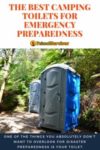

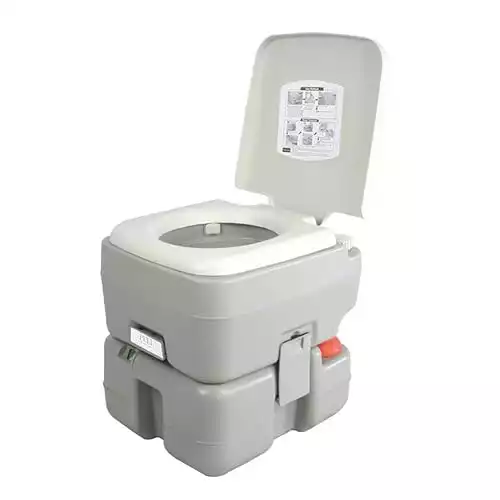
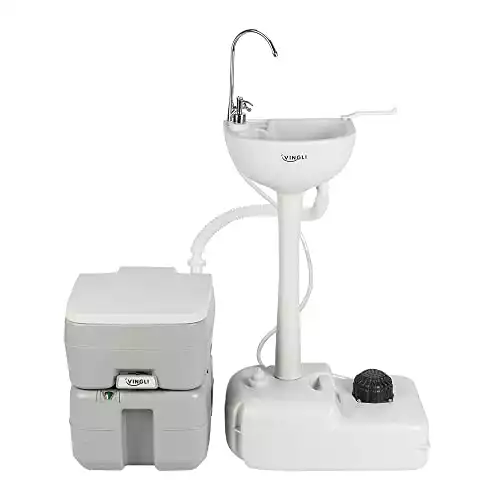


You never mentioned composting.
Here is our article on the best composting toilets.
If cow manure can be used to start fires, is it safe to burn poo? Just poo .
Thanks
Burning human waste requires very high temperatures and an accelerant so not really a feasible solution for most use cases.
I should also add that the reason cow manure works so great as fire fuel is because it is mostly dried grass. It burns so nicely and with no stink. Definitely not the case with human poo! 😮